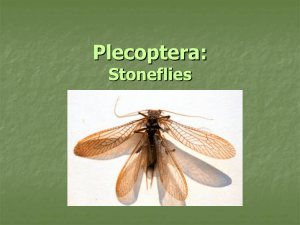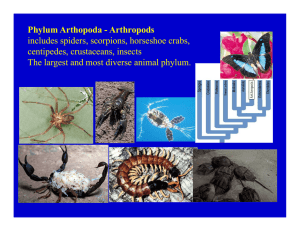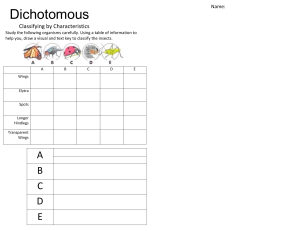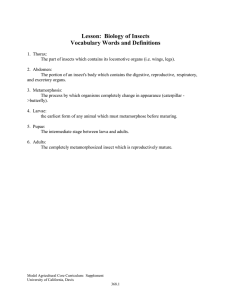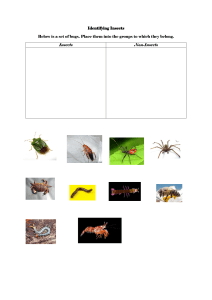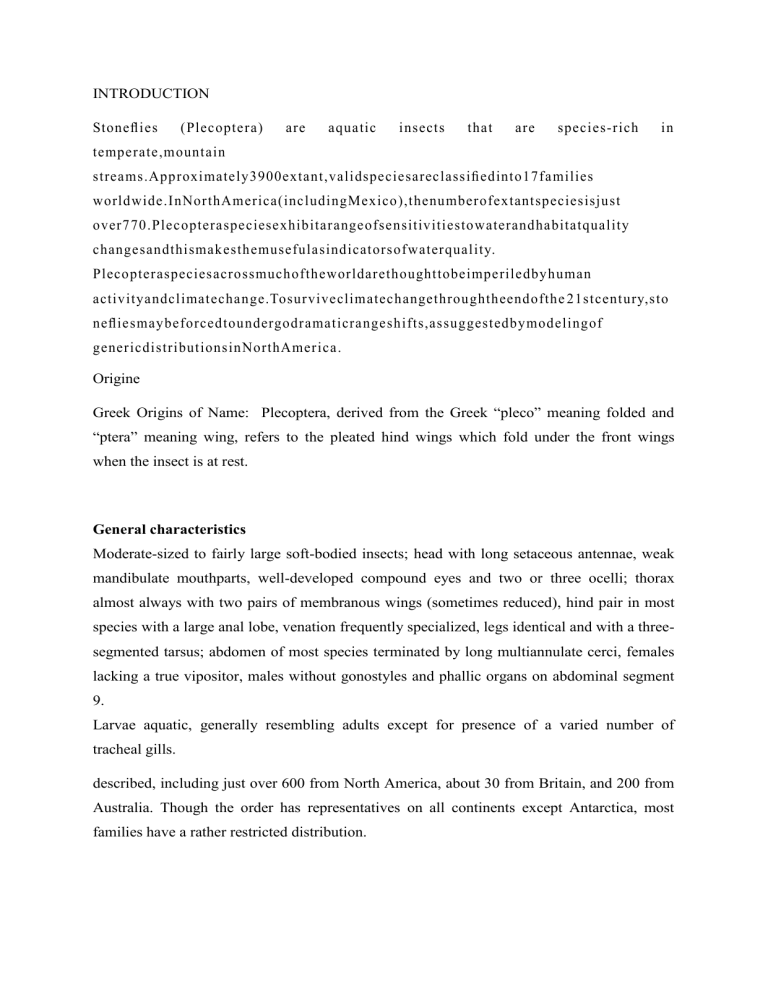
INTRODUCTION Stoneflies (Plecoptera) are aquatic insects that are species-rich in temperate,mountain streams.Approximately3900extant,validspeciesareclassifiedinto17families worldwide.InNorthAmerica(includingMexico),thenumberofextantspeciesisjust over770.Plecopteraspeciesexhibitarangeofsensitivitiestowaterandhabitatquality changesandthismakesthemusefulasindicatorsofwaterquality. Plecopteraspeciesacrossmuchoftheworldarethoughttobeimperiledbyhuman activityandclimatechange.Tosurviveclimatechangethroughtheendofthe 21stcentury,sto nefliesmaybeforcedtoundergodramaticrangeshifts,assuggestedbymodelingof genericdistributionsinNorthAmerica. Origine Greek Origins of Name: Plecoptera, derived from the Greek “pleco” meaning folded and “ptera” meaning wing, refers to the pleated hind wings which fold under the front wings when the insect is at rest. General characteristics Moderate-sized to fairly large soft-bodied insects; head with long setaceous antennae, weak mandibulate mouthparts, well-developed compound eyes and two or three ocelli; thorax almost always with two pairs of membranous wings (sometimes reduced), hind pair in most species with a large anal lobe, venation frequently specialized, legs identical and with a threesegmented tarsus; abdomen of most species terminated by long multiannulate cerci, females lacking a true vipositor, males without gonostyles and phallic organs on abdominal segment 9. Larvae aquatic, generally resembling adults except for presence of a varied number of tracheal gills. described, including just over 600 from North America, about 30 from Britain, and 200 from Australia. Though the order has representatives on all continents except Antarctica, most families have a rather restricted distribution. Life Cycle Habits Adult stoneflies are weak flyers and seldom found far from the banks of streams or edges of lakes where they rest, often well camouflaged, on vegetation, rocks, logs, etc. Nocturnal species usually hide in crevices or among vegetation during the day. Many stoneflies do not feed as adults. Others feed on lichens, acellular algae, pollen, bark, and rotten wood. Prior to mating, many Arctoperlaria tap the substrate with the tip of the abdomen (drumming). Males initiate the drumming and virgin females respond. The drumming is species-specific and serves to bring the partners together (Stewart and Maketon, 1990). Mating usually occurs in daylight, on the ground, though a few species are nocturnal. Large numbers of eggs are laid, singly or, more often, in batches of 100 or more. In flying species females hover over the water and dip the abdomen beneath the surface. Brachypterous and apterous forms crawl to the water’s edge, or below the water surface, in order to oviposit. Eggs of many species develop adhesive properties on contact with water. Embryonic development is usually direct, though eggs of some species may survive drought conditions in diapause. A few species are ovoviviparous. Larvae are typically found in streams or lakes whose bottom is covered with stones under which they can hide. Development is slow, frequently taking more than a year in the larger species. Many molts occur, 33 having been recorded over a period of 3 years for one species. Most stonefly larvae are phytophagous, feeding on lichens, algae, moss, and diatoms. Typically these are the species that also feed in the adult stage. Juveniles of other species are carnivorous, living on other insects. These species do not feed as adults. Like that of Odonata and mayflies, emergence of stoneflies is frequently highly synchronized. Metamorphosis Metamorphosis is incomplete, the life stages being the egg, naiad, and adult. Classification MAIN FAMILIES 1.Nemouroidea 2.perloidea 3.Pteronarcyoidea 4.eusthenioidea 5.Gripopterygoide Nemouridae The Nemouridae are a family of stoneflies containing more than 700 described species, occurring primarily in the Holarctic region. Members of this family are commonly known as spring stoneflies or brown stoneflies. Fly fishermen often refer to these insects as tiny winter blacks. Perloidea Perloidea is a superfamily of stoneflies. There are 1647 species of Perloidea, in 126 genera and 3 families. It includes groups like Common Stoneflies, Perlodid Stoneflies, and Green Stoneflies. Reference 1.the main reference is the text book course “Systematics and Taxonomy of insect orders 2.https://entomology.k-state.edu/extension/4-h-and-youth/Guide-to-InsectOrders/plecoptera.html#:~:text=Order%20Plecoptera&text=Metamorphosis%20is%20incom plete%2C%20the%20life,stones%20in%20rapidly%20running%20streams. 3. https://genent.cals.ncsu.edu/insect-identification/order-plecoptera
